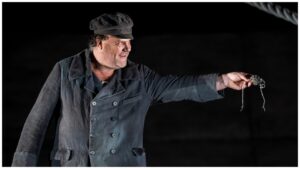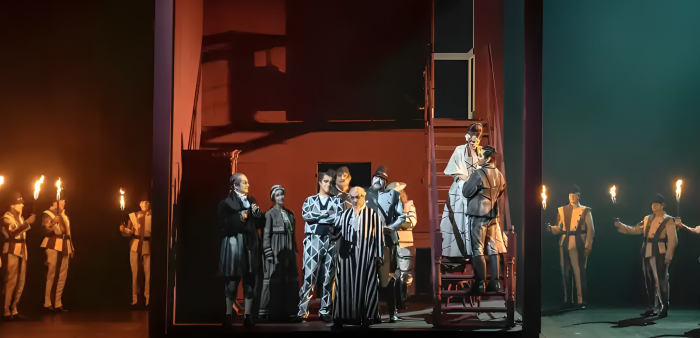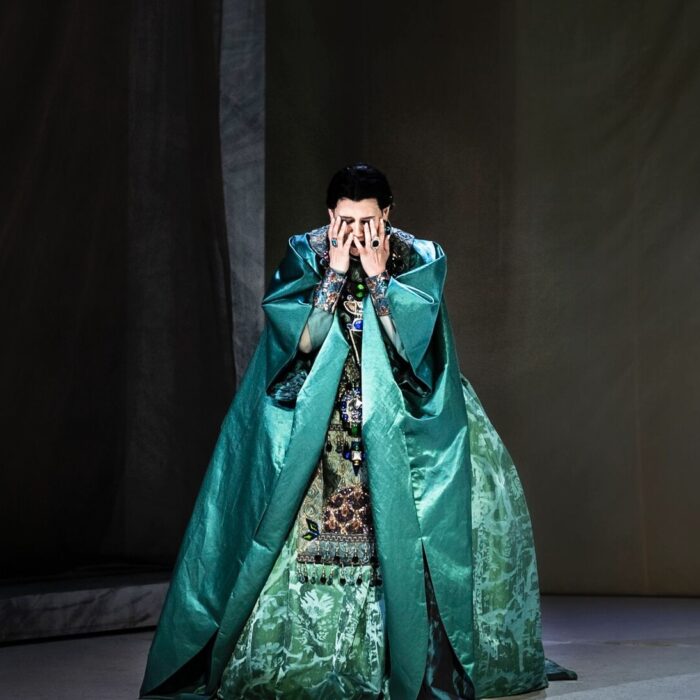
Royal Opera House 2023-24 Review: Der fliegende Holländer
Bryn Terfel Steers the Ship in Latest Revival of Tim Albery’s Production
By Benjamin Poore(Photo: © ROH 2024. Photo by Tristram Kenton)
It’s 35 years since Bryn Terfel delivered a barnstorming, roof-raising rendition of “Die Frist ist um” from “Der fliegende Holländer” at Cardiff Singer of the World. His battle then with the late Dmitri Hvorostovsky was as titanic as the great oceanic, cosmic forces that suffuse Wagner’s 1843 opera. Much has changed vocally, but Terfel’s stature has not. He returned to this signature role for the latest revival at the Royal Opera House of Tim Albery’s 2009 staging of Wagner’s story of damnation and redemption, making itself a significant debut for the composer, marking the beginning of his mature period.
Albery’s production, with imposing, sheer hull-like sets by Michael Levine and 70s drudgery in Constance Hoffman’s costumes, spotlights the existential dimensions of the piece, rather than its fairytale qualities. It’s a gloomy coastal town, with regimented banks of sewing machines and mindless work absorbing Wagner’s seamstresses, as well as a needy, neurotic boyfriend in Erik, against which Senta’s imagination rebels. The cipher for this is a model ship, representing some kind of escape from dreary small-town life. Set somewhere in the latter half of the twentieth century, there are few props and scenic elements are hefty and symbolic – two great ropes that bind the ships together forming a cross – X marks the psychological spot. The emptiness of the staging suggests something appropriately purgatorial.
The Dutchman himself is simply clad in gray – a blank surface onto which Senta’s can project her longing – and seems to represent or reflect, in his own restless despair, a similar desire to break free from drudgery. Their love scene – if one can call it that – takes place under a bare lamp with two chairs and barely a touch exchanged between them. This was contra the growing lushness of Wagner’s music but aptly alienated, picking up on the composer’s keen feeling for isolation and despair that often lurks behind many of his characters. At the climax, though betrayed, Senta is left alone on the bare stage, and collapses under her model ship – not dead, exactly, but dead inside – a kind of imaginative extinguishing.
The blocking in the opera’s climactic scene is, without a doubt, muddled and messy. The characters simply don’t know where to stand, and wander around diffusing the musical tension. At other moments the spareness works to great effect, such as in the Dutchman’s first meeting with Senta, where his starkly silhouetted against upstage, and as the lighting softens takes on a more tender aspect, though still prickly distant. It’s often atmospheric, and sometimes penetrating, but there is a lingering, directionless quality that means that it feels psychologically and dramatically unmoored.
There is a superb coup de théâtre in Wagner’s brilliantly conceived party scene, with the revelers singing out ever more aggressively into the audience to exhort the ghost sailors to action, then suddenly parting to reveal a green-hued ghostly crew. All credit to the production for the real expense of a double chorus, rather than recording it and piping them in unseen, as is often done. Before all this, torches shone into the audience create ghostly patterns on the horseshoe-shaped theater. This was simple but effective in setting the spooky mood.
One element really is cursed though. A long channel of water flows across downstage, in which people occasionally paddle or float Senta’s model boat; because it’s flat it’s invisible from anything below the balcony level, but during the overture the trickling of the water makes a terrible racket – combined with the music, it sounds like the rustling of an enormous packet of boiled sweets or crinkled paper bag. Never mind the wisdom of having running water at the beginning of an opera that proceeds for nearly two-and-a-half hours without an opportunity to go to the loo, we know what water sounds like – Wagner depicts its great foments in his score perfectly well, and neither Henrik Nánási, nor orchestra, nor chorus, needed mechanical help bringing it to life.
But what of Terfel? By now he’s got the Dutchman in his bones, both vocally and dramatically; he even just put out an album of Sea Shanties on Deutsche Grammophon. Compared to 1989, the sound is less burnished and powerful, especially in the top. But, five seven-year-long voyages on the operatic high seas will do that to a voice. Terfel, rather than trying to recreate the glories of the past, is far cannier about making the most of his instrument. His considerable dramatic presence allows him to get away with a few careful swoops up the very highest notes in the nosebleed tessitura, for certain, but Terfel is able to make even slightly effortful singing sound a Lear-like quality, familiar from his numerous Sachs’ and Wotans.
There is also a remarkable delicacy, with Terfel using a feathery head voice, almost falsetto, to find moments of extraordinary vulnerability and tenderness. There is a palpable sense that this Dutchman really has weathered a great deal. He is a singer who really dares to sing quietly, which is a drama all of its own. The orchestra could probably stand to get out of the way at times. When Terfel was studying down the road at the Guildhall, the first years of his instruction were in English song – his words are so chunky and alive they render surtitles superfluous. A director colleague of mine always tells casts before opening night that they should sing as if the surtitles aren’t working; Terfel is the object lesson in how effective that can be.
Elisebet Strid, making her Covent Garden debut, sang a steely Senta as his counterpart. The love interest feels a strange way to describe their chilly, fateful obsession, despite Wagner’s exalting music in their love duet. She was relatively untroubled by the passaggio tribulations of her big opening number, striking her high notes with clarity and purpose. There was an apt sense of the character’s own determined, obsessive dedication. Her more lyrical moments were searing, at times a little wayward in terms of tuning, and with a less defined lower register – rather than luxurious. But, it all felt like it was in service of a bracing portrait of a character. This power and brightness served her especially well in the final scene, which allowed her top notes to really gleam.
Stephen Milling’s Daland cut an affable dash as the captain on the make. It’s not the most compelling dramatic territory and vocally found his feet eventually, even though it took a while to warm up, perhaps wrong-footed by Wagner’s rather awkward registration. His sound was less secure and more threadbare than in the inky, oaky performances of Hagen and Pogner which he has given in this house.
Toby Spence, who has recently starting to plough a Wagnerian furrow in as Parsifal with Opera North, takes on another rather rather unyielding role as Erik. There were challenges, certainly, with a few moments of wayward tuning and inconsistent production. But he nonetheless gave, in voice and movement, a convincingly neurotic, needy, and impulsive portrait of Senta’s would-be boyfriend – the antepenultimate aria of the whole piece a particular highlight. The Steersman is always one to watch, and Miles Mykkanen was one of the sweetest and most clarion-voiced I’ve heard in some time, with effortless ascents and a creamy top. This was a reminder that this music is completely steeped in bel canto traditions.
The chorus was in typically thunderous form. The most exciting singing, as ever, is actually the quietest, and they floated in an ethereal, penumbral ‘auf’ from offstage in Act one. Henrik Nánási whipped the orchestra into a frenzy with a brisk account of the overture that very much set aside Wagner’s indebtedness to Mendelssohn’s classicism in its lacerating vigor, with a highly-focused string sound soaking us through the bones. Tempi were brisk and the tension well-maintained, with moments of release truly thunderous. When Terfel sings of the “Vernichtungsschlag” – the hammer blow of annihilation on Judgment Day – the orchestra responded by showing us exactly what it might sound like. Despite some choppy moments, Terfel and Nánási had firm hands on the tiller.


